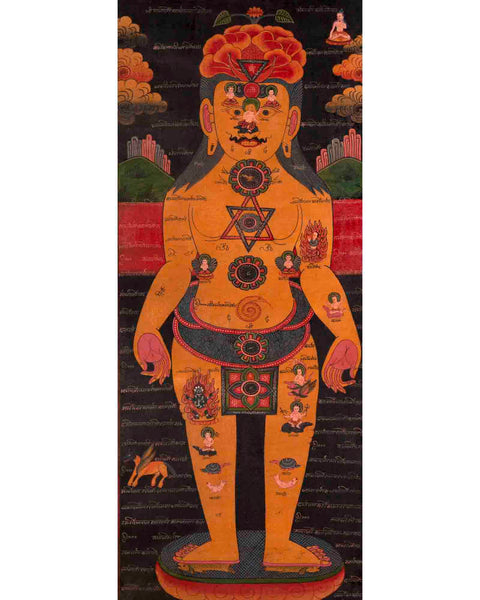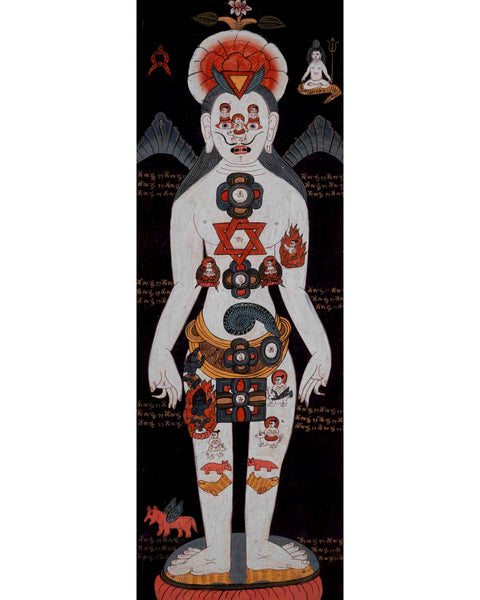7 Chakra Kundalini Healing Chakra System Thangka
The Kundalini Seven Chakra Yoga Meditation Thangka intricately depicts the spiritual journey in Tibetan Buddhism and Hindu philosophies. This artistic masterpiece serves as a visual aid for meditation, offering profound insights into the chakras. Beyond its visual appeal, it symbolically represents the awakening and ascension of Kundalini energy through yoga and meditation practices.
Key Takeaways
- Kundalini Yoga: A form of yoga that focuses on awakening Kundalini energy located at the base of the spine.
- Seven Chakras: Represent the seven energy centers in the body, each with unique qualities and functions.
- Thangka Painting: A traditional Tibetan scroll painting that depicts various spiritual themes, including the Kundalini and chakras.
- Meditation and Spiritual Growth: Thangkas are used as aids in meditation, helping practitioners to visualize and align the chakras and awaken the Kundalini.
Understanding Kundalini Yoga: The Concept of Kundalini
Kundalini, often symbolized as a coiled serpent at the spine's base, holds a key role in yoga and Tantra, where awakening this dormant energy is believed to usher in spiritual enlightenment. Once awakened, this energy ascends through the chakras, fostering an elevated state of consciousness.
Practices in Kundalini Yoga: Kundalini Yoga and Meditation
In the realm of Kundalini Yoga, a fusion of postures (asanas), chanting (mantras), breath control (pranayama), and meditation is employed. These practices are designed to rouse the Kundalini energy, directing it through the chakras and facilitating a harmonious equilibrium across the practitioner's physical, emotional, and spiritual dimensions.
| Component | Description |
| Asanas | Physical postures to prepare the body |
| Mantras | Chants to focus and elevate the mind |
| Pranayama | Breath control to regulate energy flow |
| Meditation | Techniques for mindfulness and awareness |
The Seven Chakras: Overview of Seven Chakras Yoga

Click here to view our Seven Chakra Kundalini Yoga Thangka
The chakras, seven energy centers aligned along the spine, are linked to distinct facets of physical, emotional, and spiritual well-being. Imagined as dynamic wheels of energy, each possesses a unique vibrational frequency and color.
Detailed Look at Each Chakra
- Root Chakra (Muladhara): Found at the spine's base, it signifies stability, grounding, and basic needs. The color red symbolizes vitality and strength.
- Sacral Chakra (Svadhishthana): Below the navel, it relates to creativity, sexuality, and emotional balance. Orange, its color, signifies creativity and pleasure.
- Solar Plexus Chakra (Manipura): In the stomach area, it embodies personal power, self-confidence, and goal achievement. Yellow symbolizes energy and transformation.
- Heart Chakra (Anahata): Centered in the heart area, it represents love, compassion, and empathy. Its color, green, symbolizes healing and harmony.
- Throat Chakra (Vishuddha): Positioned at the throat, it governs communication and self-expression. The color blue reflects the ability to speak truthfully and listen effectively.
- Third Eye Chakra (Ajna): Located on the forehead between the eyebrows, it symbolizes intuition, foresight, and a connection to spiritual realms. The indigo color represents wisdom and inner knowledge.
- Crown Chakra (Sahasrara): At the head's top, it links us to the divine and higher consciousness. Violet, its color, signifies spiritual connection and enlightenment.
The Seven Chakras and Their Attributes:
| Chakra | Location | Attributes | Color |
| Muladhara | Base of Spine | Stability, Grounding | Red |
| Svadhishthana | Below Navel | Creativity, Sexuality | Orange |
| Manipura | Solar Plexus | Power, Confidence | Yellow |
| Anahata | Heart | Love, Compassion | Green |
| Vishuddha | Throat | Communication, Expression | Blue |
| Ajna | Forehead | Intuition, Insight | Indigo |
| Sahasrara | Crown of Head | Spiritual Connection | Violet |
Thangka Paintings in Meditation

Role of Thangkas in Spiritual Practice
Thangkas transcend mere art, serving as tools for meditation and spiritual instruction. They visually depict intricate spiritual concepts, enhancing focus and contemplation.
Specifically, a Kundalini Seven Chakra Yoga Meditation Thangka typically illustrates the coiled serpent of Kundalini at the base, alongside the seven chakras along the spine, adorned with corresponding symbols and colors.
This visual aid is crucial in guiding practitioners through meditation and yoga, facilitating the visualization of each chakra's awakening and the ascent of Kundalini energy.
Kundalini and Chakra Thangkas
Within Kundalini and Chakra Thangkas, individual chakras are often portrayed with their associated color, symbol, and sometimes the deity linked to that specific chakra.
The coiled serpent, representing Kundalini, is prominently featured at the spine's base, poised for ascent through the chakras. This symbolic journey mirrors the spiritual awakening and the quest for enlightenment.
The Kundalini Seven Chakra Yoga Meditation Thangka is a captivating and potent instrument in pursuing spiritual awakening. Functioning as a visual guide in meditation, a wellspring of inspiration in yoga, and a conduit connecting the practitioner to ancient wisdom, this art form is beautiful and influential.
Laden with symbolism and entrenched in spiritual tradition, it provides a unique glimpse into the mystical realm of Kundalini Yoga and the transformative journey through the chakras.
The Artistic Elements of Thangka
-
Thangka Art Symbolism
Every aspect within a Thangka painting, ranging from colors to shapes, carries profound symbolic significance. The serpent, for example, symbolizes Kundalini energy, while each chakra is represented with a specific color and symbol. The intricate designs and patterns in these artworks offer aesthetic appeal and convey profound spiritual meanings. -
Techniques and Materials
In crafting traditional Thangka paintings, artists employ natural pigments and gold on cotton or silk canvases. The process is meticulous and holds profound spiritual importance. Typically undertaken by monks or spiritually inclined individuals, creating a Thangka involves meditation and chanting. This intentional process infuses the artwork with positive energy and spiritual intentions, elevating its significance beyond visual aesthetics.
Integrating Thangka in Yoga and Meditation
Thangka Paintings in Chakra Meditation
Thangka paintings serve as a focal point during meditation, aiding practitioners in visualizing the alignment and awakening of chakras and the ascent of Kundalini energy. This visualization is pivotal in Kundalini Yoga, directing energy flow through the body and fostering focused mindfulness.
Elevating Yoga Practice
In a yoga environment, a Thangka is a visual reminder of the energetic and spiritual dimensions inherent in the practice. It prompts a deeper connection to the inner self, creating a sacred space that supports practitioners on their journey of self-discovery and spiritual growth.
Cultural and Spiritual Significance
Thangka's Significance in Tibetan Culture
Thangka paintings occupy a revered position in Tibetan culture, embodying the region's profound spiritual essence and artistic legacy. Beyond being mere art objects, they are regarded as sacred items endowed with spiritual power and deep significance.
Universal Resonance
Although rooted in Tibetan Buddhism, the themes of Kundalini and chakras depicted in Thangkas transcend cultural boundaries, resonating with various spiritual traditions. This universal appeal makes Thangkas highly valued by practitioners across diverse spiritual paths, appreciating their beauty, symbolism, and efficacy in supporting spiritual practices.
In essence, the Kundalini Seven Chakra Yoga Meditation Thangka transcends being a mere art piece; it acts as a spiritual map, skillfully steering practitioners through layers of consciousness toward the ultimate goal of enlightenment. Its intricate design and profound symbolism render it an invaluable tool for anyone navigating the path of spiritual discovery and personal growth.














